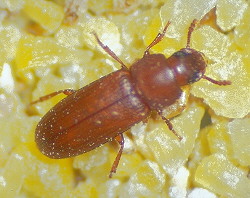Insect Pests of Stored Grain: Flour Beetle
ENTFACT-135: Insect Pests of Stored Grain: Flour Beetle | Download PDF
Confused Flour Beetle--Tribolium confusum
Red Flour Beetle--Tribolium castaneum
(Coleoptera: Tenebrionidae)
by Doug Johnson, Extension Entomologist
University of Kentucky College of Agriculture
Flour beetles, often called "bran bugs", are probably the most common stored grain insect pests in Kentucky. They are common throughout the state.
Damage
Flour beetles are secondary pests, which means that they feed on dust, fines and dockage. While both species cause damage by feeding, they are more important as contaminants. Large numbers of dead bodies, cast skins and fecal pellets, as well as liquids (quinones), can give grain an extremely pungent odor.
Description
Both beetles are red-brown and about 0.1 inch long. They are very similar in appearance (the Red Flour Beetle is pictured right), but can be distinguished by the shape of the club on their antennae. The club or last segments of the antenna of the confused flour beetle gradually enlarge toward the tip. The last few segments of the red flour beetle's antennae increase abruptly in size. In addition, the head margins of the confused flour beetle are enlarged and notched at the eye with a ridge over the eye. The red flour beetle head margins are nearly continuous with no ridge.
Full grown larvae are less than 0.3 inch long, yellow-white worms. The head and the pair of projections on the tip of the abdomen are dark.
Biology
Under favorable conditions, a female may lay 400 or more eggs at a rate of 6 to12 per day. The eggs are covered with a sticky fluid which allows particles of debris to adhere to them resulting in almost perfect camouflage. There are generally four larval stages; the egg to adult life cycle takes about 30 days.
Prevention is always the most economical and efficient method of controlling these pests. Once they are distributed within the grain mass, the grain must be moved and sprayed as it is being moved, or fumigated in the bin to relieve the problem. Removal of fines and dockage will aid in control and prevention.
For specific insecticide recommendations for individual crops see:
- Corn, Field - Insecticides for Corn, ENT-16
- Popcorn - Insecticide Recommendations for Popcorn - ENT-62
- Sorghum - Insecticide Recommendations for Sorghum (Milo) - ENT-24
- Soybeans - Insecticide Recommendations for Soybeans - ENT-13
- Wheat - Insecticide Recommendations for Small Grains - ENT-47
These publications are available at local county extension offices in Kentucky.
Issued: 8/00
Revised: 7/09
CAUTION! Pesticide recommendations in this publication are registered for use in Kentucky, USA ONLY! The use of some products may not be legal in your state or country. Please check with your local county agent or regulatory official before using any pesticide mentioned in this publication.
Of course, ALWAYS READ AND FOLLOW LABEL DIRECTIONS FOR SAFE USE OF ANY PESTICIDE!
Photo courtesy Ric Bessin, University of Kentucky Entomology

